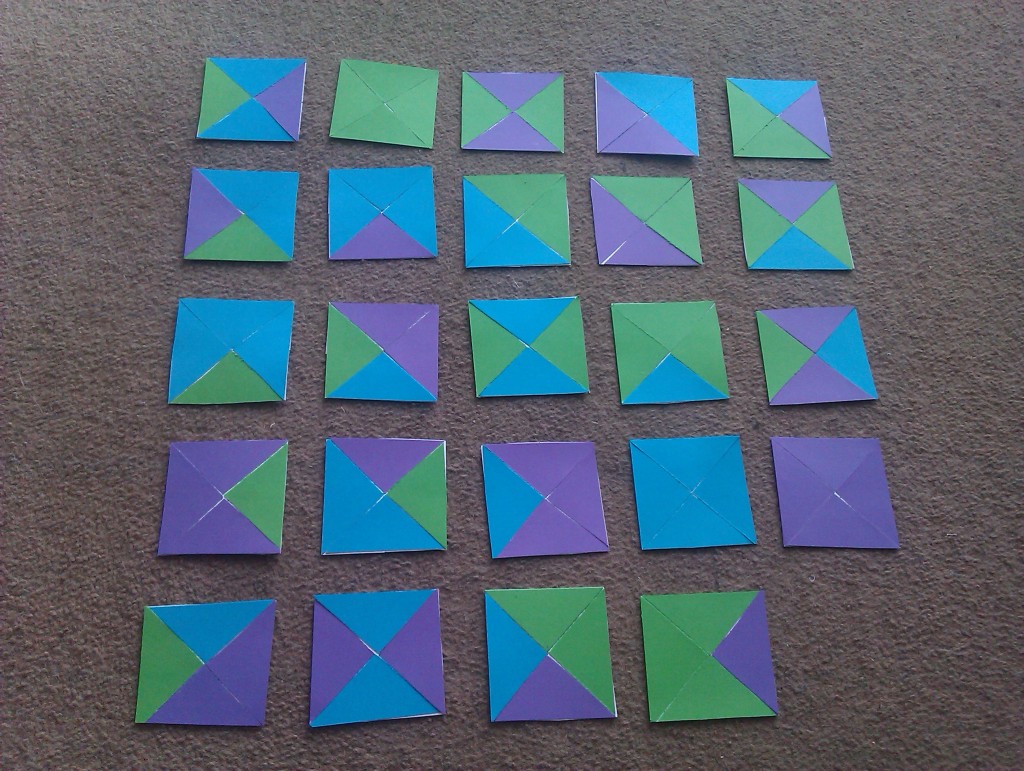In my capacity as someone who occasionally turns up and does maths at people, I often find myself exposed to ‘starter puzzles’ – things the organisers provide to whichever group of humans have come to see me do maths, to give them something to do in any waiting time before the event starts. This is, of course, a fantastic source of ideas for the MathsJam I run in Manchester, as well as just being great for me as I get to have a go at them all.
At once such event recently, the person running the session had brought a fantastic set of MacMahon squares, cut from perspex, which he’d made himself and provided a nice activity for people to play with. MacMahon squares are a set of 24 squares, each made up of four right-angled triangles, which are each coloured in one of three colours, so that every possible square is present. Percy MacMahon invented them in 1921. I’ve made a set from card, and they are pictured below.
A nice easy initial challenge is to arrange the 24 squares into a 6×4 rectangle such that every pair of touching triangles is of the same colour. This is easily achieved, and acts as a warm-up to the main puzzle.
The challenge then is to repeat this feat of edge-matching, but this time making sure that the whole outside edge of the rectangle is of a single colour. There are multiple solutions, and some are given here and here (both of which differ from the solution we got messing around with my set). It can probably be achieved by trial and error, although there are several nice deductions which can be made (using maths!) to determine certain restrictions on where some of the pieces can go.
If you’d like to have a play, I’ve made a printable version of the tiles which can be cut out when printed onto card.
There are hundreds of edge-matching puzzles, and Tetravex is an example of one based on the same shapes (although more than three colours are used). MacMahon is also credited with the idea of a set of equilateral triangles, each split into three isosceles triangles, coloured using 4 colours to give a set of 24.
Frustratingly little is said online about MacMahon squares – Wikipedia merely states that “MacMahon also did pioneering work in recreational mathematics and patented several successful puzzles”, alongside a lot of information about his military career. This website states that Wade Philpott was an American engineer responsible for investigating all the possible solutions, and here it is explained he used computer search programs to determine all the shapes which can be created, while sticking to the edge-matching and outer border constraints.
Wade Philpott also released purchasable sets of tiles, as the game ‘Multimatch’, which not only has four versions (edge-coloured and corner-coloured / squares and equilateral triangles), but also shares its name with about a million other games and toys on the market. Along with bafflingly many other different edge-matching tile sets found here, his laser-cut acrylic version of the original MacMahon Squares, accompanied by a book which “encompasses thirty years of research into this set”, is available here – including, tantalisingly, “rules for several games”.

I think you can make these tiles by filling a grid with 3 colours, then cutting along the diagonals. Can you do it with a grid of area
I enjoyed your posting. I have been “studying” MacMahon for the last 2 years and have been using self constructed squares, triangles and cubes for math classes just as long. My blog: http://mathonthemckenzie.blogspot.com/ has several links to sources on information on MacMahon. Your Mathsjam looks cool.
I found a fast method to find the exhaustive list of solutions for mac Mahon types of puzzles. I’d like your view on it.
Step 1) choose two colours (for example blue and green) and consider them to be identical.
Step 2) solve the puzzle (it is a lot easier now that there is only blue-green and red. There is far less solutions too.
Step 3) for each solution, the red parts are now fixed. You only find to swipe the tiles and count the solutions.
When traditional methods with basic optimization can find all solutions in 30 seconds or so, using this technique you get the same result in less than two seconds.
https://www.codeproject.com/Articles/9840/C-vs-VB-contest-Resolving-Mac-Mahon-problem-using
On a PC I can find all solutions